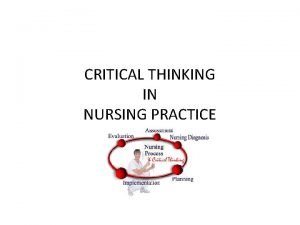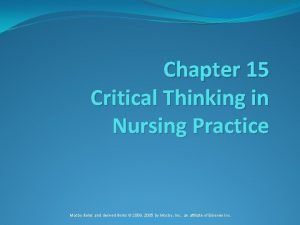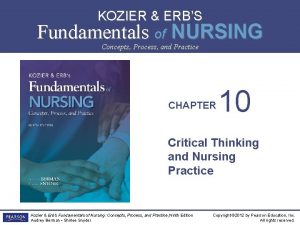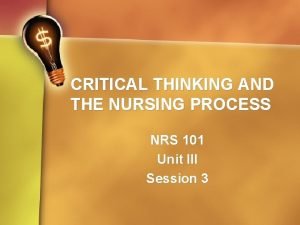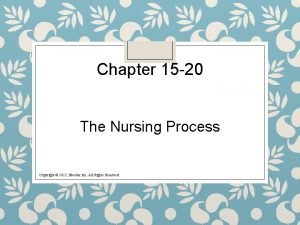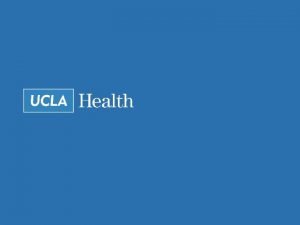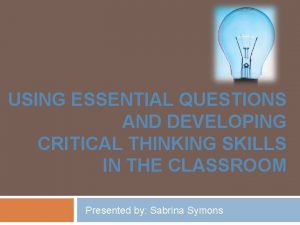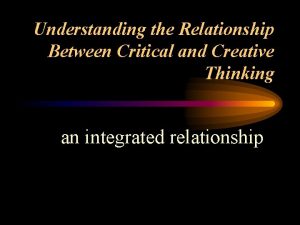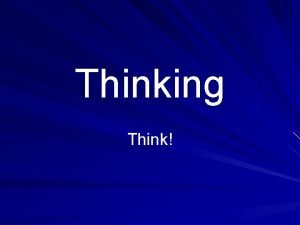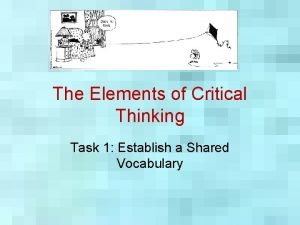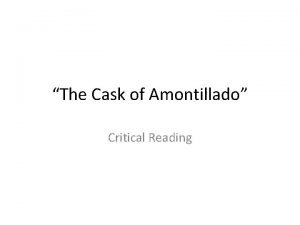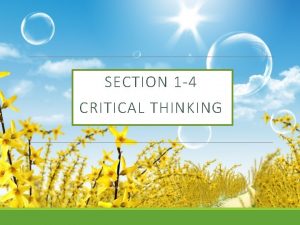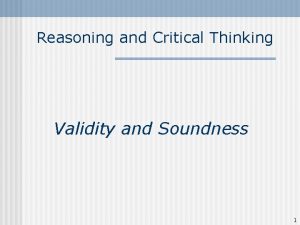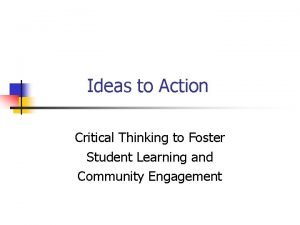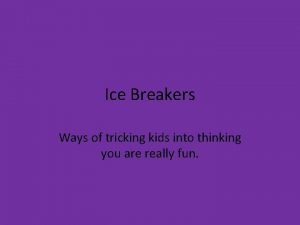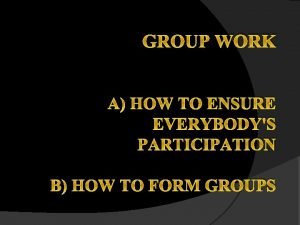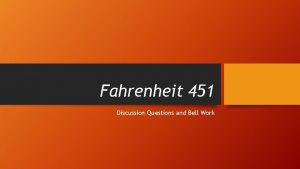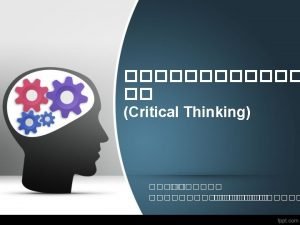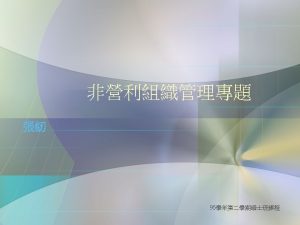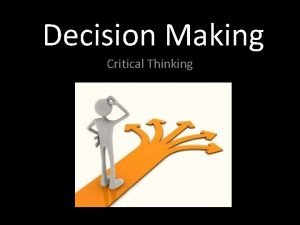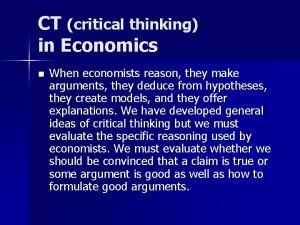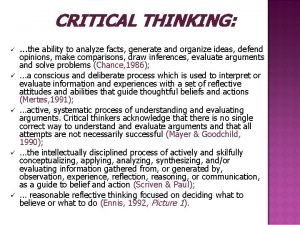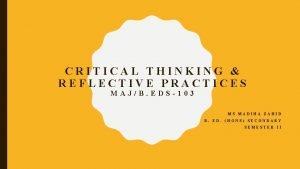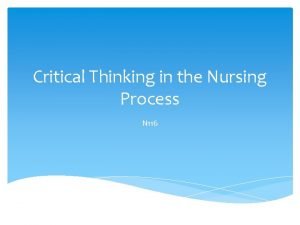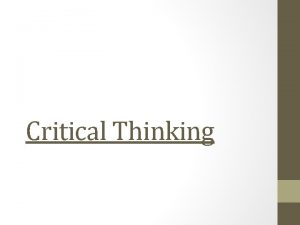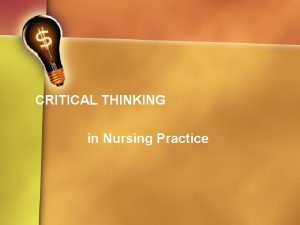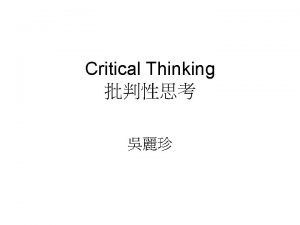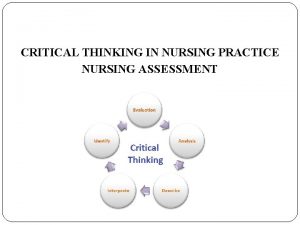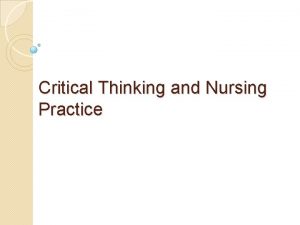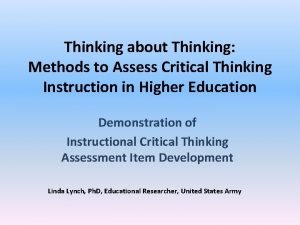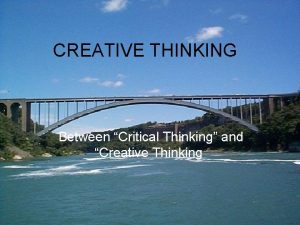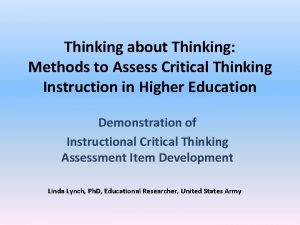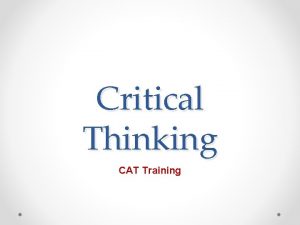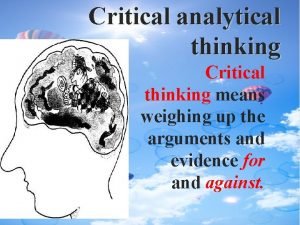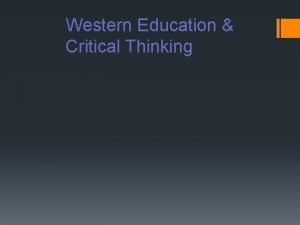CRITICAL THINKING IN NURSING PRACTICE IDEAS What is

































- Slides: 33

CRITICAL THINKING IN NURSING PRACTICE

IDEAS • • • What is critical thinking Critical thinking skills Experience and expertise Nursing process overview Practice questions

WHAT IS CRITICAL THINKING • Purposeful, goal-directed thinking process that strives to problem solve patient care issues through the use of clinical reasoning. • Combines logic, intuition, and creativity. • Essential to nursing practice and clinical decision making. • The ability to function purposefully and precisely

WHAT IS CRITICAL THINKING (CONTINUED) • Chafee (2002) – Active, organized, cognitive process used to examine one’s thinking and that of others • Settersten and Lauver (2004) – It involves recognizing an issue exists, analyzing information about the issue, evaluating the issue, and making conclusions.

CRITICAL THINKING SKILLS • • • Interpretation Collect data in an orderly fashion Decode hidden messages Clarify the meaning of information Look for patterns Categorize information

CRITICAL THINKS SKILLS (CONT) • • • Analysis Examines ideas and data Open-minded Don’t jump to conclusions Identifies discrepancies Reflects on reasons for discrepancies

CRITICAL THINKING SKILLS (CONT) Inference • Speculate meaning or significance of the findings • Ability to derive meaning or reason is a skill that is developed with experience • Conclusions drawn from the facts, going beyond facts to make a statement about something not currently known.

CRITICAL THINKING SKILLS (CONT) Evaluation • Examines the validity of the information • Leads to final conclusion that can be implemented • Use reflective thinking to evaluate actions

CRITICAL THINKING SKILLS (CONT) Self-Regulation • Reflects on critical thinking skills and determines what techniques were effective and which were problematic

CRITICAL THINKING SKILLS (CONT) Explanation • Scientific rationale, nursing literature and experience serves as justification for clinical decisions

EXPERIENCE AND EXPERTISE • EXPERIENCE – is acquired when actual practice refines knowledge that has been learned through theory or actual involvement. • EXPERTISE – is the result of the accumulation of knowledge and skill from experiences.

NURSING PROCESS OVERVIEW • Use of the nursing process enables the nurse to: • Assess a patient’s health care needs • Determine nursing diagnosis • Plan care • Implement nursing interventions • Evaluate the effectiveness of care

WHY DO NURSES NEED TO CRITICALLY THINK? • Decisions require drawing on knowledge from other disciplines • Dealing with change in a stressful environment • Making frequent, varied, important decisions • Involving health, safety and welfare of patients • Including holistic application

ASK YOURSELF • How much ambiguity can be tolerated? • What are my options? • What are the alerts for today with this patient? • What are the important assessments to make? • What complications may occur? • What interventions will prevent complications?

REMEMBER • Nursing students need to not just be “doers”, but be “thinkers. ” • Nurses use critical thinking in decision making to help them choose the best action to meet desired goal.

CRITICAL THINKING ATTITUDES • • Confidence Thinking independently Fairness Responsibility Risk Taking Discipline Perseverance

CRITICAL THINKING ATTITUDES (CONT) • • Creativity Curiosity Integrity Humility

PUTTING THE PIECES TOGETHER CRITICAL THINKING PRACTICE • A client with diarrhea also has a primary care provider’s order for a bulk laxative daily. The nurse, not realizing that bulk laxatives can help solidify certain types of diarrhea, concludes, “The primary care provider does not know the client has diarrhea. ” This statement is an example of: a. A Fact b. An inference c. A Judgment d. An opinion

Rationale for Question 1 • B – Inference The nurse has inferred and concluded something that is beyond the available information (and in this case may not be accurate). The prescription and the diarrhea are facts (option a). It would be judgment and opinion if the nurse stated that the laxative would make the diarrhea worse and should not be given (option c & d). (NOTE: Critical thinking will cause this nurse to examine the assumptions made and gather more data before acting).

QUESTION 2 • A client reports feeling hungry, but does not eat when food is served. Using critical thinking skills, the nurse should perform which of the following? a. Assess why the client is not ingesting the food provided. b. Continue to leave the food at the bedside until the client is hungry enough to eat. c. Notify the primary care provider that tube feeding may be indicated soon. d. Believe the client is not really hungry.

Rational for Question 2 • A. assess why the client is not ingesting the food provided. The nurse recognizes that many assumptions (beliefs) could interfere with the client eating – such as that the food presented is not culturally appropriate. These assumptions must be clarified. Options b & c reach conclusions not supported by the facts. In option d, the nurse has made a judgment or has an opinion that may not be accurate. Also, the nurse is acting without assessment. Implementation should be preceded by assessment.

QUESTION 3 • The nurse is concerned about a client who begins to breathe very rapidly. Which action by the nurse reflects critical thinking? a. Notify the primary care provider. b. Obtain vital signs and oxygen saturation. c. Request a chest x-ray. d. Call the rapid response team.

Rationale for Question 3 • B – Obtain vital signs and oxygen saturation. The nurse’s intuition is like a sixth sense that allows the nurse to recognize cues and patterns to reach correct conclusions. The nurse appropriately obtains vital signs and an oxygen saturation to assess the client’s clinical picture more fully. Option a supports appropriate nursing actions, but the client’s respiratory status should be assessed first. Usually, a physician must order a chest x-ray (option b). The rapid response team (option d) may be needed if the client’s condition becomes more critical.

QUESTION 4 • A client in a cardiac rehabilitation program says to the nurse, “I have to eat a low-sodium diet for the rest of my life, and I hate it!” Which is the most appropriate response by the nurse? a. “I will get a dietary consult to talk to you before next week. ” b. “What do you think is so difficult about following a low-sodium diet? ” c. “At least you survived a heart attack and are able to return to work. ” d. “You may not need to follow a low-sodium diet for as long as you think. ”

Rational for Question 4 • B – “What do you think is so difficult about following a low-sodium diet? ” Information from the client in order to respond directly to the client’s statement. Option a passes off the client’s educational needs to another practitioner. Options c & d are nontherapeutic.

QUESTION 5 • A coworker asserts: “men always seem to exaggerate pain, ” the nurse who is thinking critically might ask: a. “Where did you read that? ” b. “Who told you that? ” c. “What evidence do you have for that? ” d. “How many male patients have you had? ”

Rational for Question 5 • C – “What evidence do you have for that? ” The importance of critical thinking is valued in nursing. Skills to hone critical thinking can be obtained through education and experience. Options a, b, and d are merely asking for further information.

QUESTION 6 • The nurse enters the room of a patient who has a history of heart disease. On looking at the patient the nurse feels something is “not right” and proceeds to take the vital signs. The nurse is acting on: a. Intuition b. Reflection c. Knowledge d. Scientific methodology

Rationale for Question 6 • A – Intuition The nurse knows that the meaning of intuition is the understanding or learning of things without conscious use of reasoning. Nurses are able to judge quickly which evidence is most important and to act on that limited evidence.

QUESTION 7 • Which of the following is the best example of a nurse’s use of deductive reasoning? a. The nurse places a patient experiencing respiratory difficulties in a high Fowler’s position b. The nurse calls the provider when a patient who has an oral temp of 100. 2 reports feeling “chilled and achy” c. While caring for a patient with a history of asthma, the nurse assesses the patient’s pulse ox reading when he “doesn’t sound right” d. A nurse tells a patient “when you refused to go to physical therapy earlier today I believe you were upset about something else besides the appointment time”

Rationale for Question 7 • D- A nurse tell a patient “when you refused to go to physical therapy earlier today I believe you were upset about something else besides the appointment. ” By contrast, is reasoning from the general premise to the specific conclusion. For example: the nurse might categorize data and define the client’s problem in terms of elimination, nutrition, or protections needs.

QUESTION 8 • When a 4 -year old child refuses to take a medication in pill form because it is “too big and it hurts when I swallow, ” the nurse demonstrates critical thinking by: a. Asking the mother how she gets him to cooperate. b. Allowing the child to skip a dose this one time and documenting the reason why. c. Asking the nurse-manager what to do. d. Checking with the pharmacy to see if the medication can be dispensed in liquid form

Rational for Question 8 • d – Checking with the pharmacy to see if the medication can be dispensed in liquid form. Part of critical thinking is being creative in approaches to difficult situations. Asking the mother how she gets him to cooperate may be helpful, but is not using critical thinking. It is never correct for the nurse to allow the child to skip a dose. Asking the nurse-manager what to do may be helpful, but it is not critical thinking.
 Critical thinking in nursing process
Critical thinking in nursing process Fundamentals of nursing chapter 15 critical thinking
Fundamentals of nursing chapter 15 critical thinking Critical semi critical and non critical instruments
Critical semi critical and non critical instruments Critical semi critical and non critical instruments
Critical semi critical and non critical instruments Perbedaan critical thinking dan creative thinking
Perbedaan critical thinking dan creative thinking Nursing inferences examples
Nursing inferences examples Nursing process objectives
Nursing process objectives Critical thinking in nursing process
Critical thinking in nursing process Fundamentals of nursing chapter 15 critical thinking
Fundamentals of nursing chapter 15 critical thinking Unit practice council nursing ideas
Unit practice council nursing ideas Slidetodoc.com
Slidetodoc.com Barriers to critical thinking
Barriers to critical thinking Critical thinking guidelines
Critical thinking guidelines Critical thinking examples
Critical thinking examples Relationship between creative and critical thinking
Relationship between creative and critical thinking Critical thinking in daily life
Critical thinking in daily life Elements of critical thinking
Elements of critical thinking The cask of amontillado critical thinking questions
The cask of amontillado critical thinking questions Critical thinking examples
Critical thinking examples False premise example
False premise example Active learning strategies to promote critical thinking
Active learning strategies to promote critical thinking 5 components of critical thinking
5 components of critical thinking Critical thinking icebreakers
Critical thinking icebreakers Critical thinking in group work
Critical thinking in group work Discussion questions fahrenheit 451
Discussion questions fahrenheit 451 Define:actually
Define:actually Linear thinking wikipedia
Linear thinking wikipedia One case of dehydrated milk
One case of dehydrated milk Objective claim
Objective claim Critical thinking cheat sheet
Critical thinking cheat sheet Analyzing the facts is ________.
Analyzing the facts is ________. Critical thinking wheel
Critical thinking wheel Critical thinking and reflective practices
Critical thinking and reflective practices 5 components of critical thinking
5 components of critical thinking
